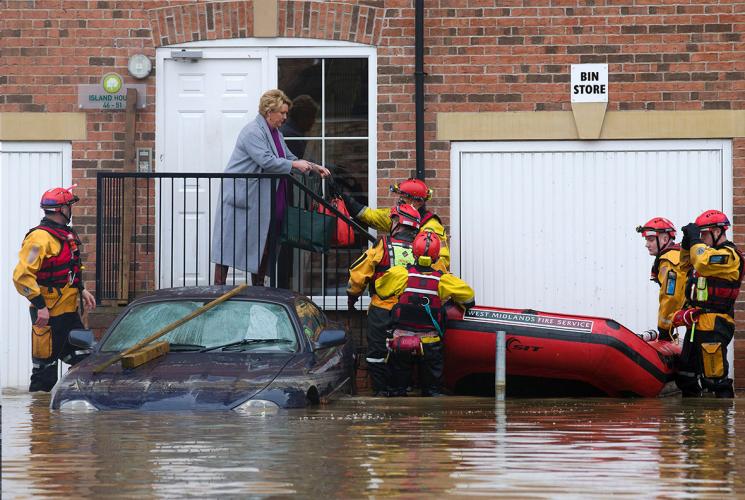Imagine the UK's national network of railway stations. How would you decide where to build a new station? There are many options – you could put it somewhere remote, where the impact on travel will be large for a small group of people. On the other hand, you could put it somewhere more populated, where it will have a smaller impact on a larger group of people, who will have less far to travel to reach their nearest station.
There are other factors to consider too. What amenities will the new station have? Which trains will stop there? Will it poach competition from other nearby stations?
 Computers can help us make these kinds of decisions by using existing data to make predictions. We can build mathematical models of the world around us, and use computers to run them.
Computers can help us make these kinds of decisions by using existing data to make predictions. We can build mathematical models of the world around us, and use computers to run them.
First, we build a mathematical model of the problem based on what we observe. For example, for the railway station problem above, we might say that we should build whichever station has the biggest impact on its local population. If we imagine that impact (i) is equal to number of people served (p) multiplied by travel time saved (t), then we get a model which looks like:
i = p x t
Then, all we have to do to find out which station to build is to feed in data about the two possible locations. The remote station location has low p (fewer people served) but high t (lots of time saved). The more populated station location has high p (more people served) but lower t (less time saved travelling to their nearest station). Depending on the data we use, we will get different answers about which station will have the most impact.
"In reality, the models used to predict things like where railways stations should be built are much more complicated, with many different factors to consider. They also use data from lots of different places to reach a conclusion," says Marion Samler, who is part of DAFNI, a team that aims to bring together the data, the computational capability and the people who need it.
"This is why we often use computers to model real-life situations, because they can work through the calculations very quickly. Most decisions about how to build and improve infrastructure are made in this way."
The term "infrastructure" covers a range of systems, from railways to energy supply to telecommunications networks. They are inherently complex and interwoven, but researchers have found ways to model them nonetheless.
However, they come up against two problems. Firstly, it can be difficult to get access to the high-quality data needed to make the models accurate, because it comes from a range of sources. Secondly, the models are so big and complicated that a normal computer struggles to work them out.
Marion explains that this is where DAFNI (Data and Analytics Facility for National Infrastructure) comes in. "The DAFNI team has spent a lot of time building the computational platform to enable the data to be scalable and accessible to users who are not software engineers – so you don't need specialist knowledge to be able to use the system. And they have also been installing measures to ensure that the data being stored is secure and accessible only by the people who have permission to use it."
DAFNI combines access to quality data with the computing resources needed to work rapidly through large and complex models, so decision-makers can make efficient and informed assessments of need. It also stores models in a central place so others can use them, which encourages collaboration and reduces replication.
"Today, unprecedented amounts of data are at our fingertips in an instant. New technologies such as artificial intelligence and machine learning offer the potential for the UK's existing infrastructure to become smarter and work as an optimised system. DAFNI provides a strong platform to help us to do this," says Sir John Armitt, Chair of the National Infrastructure Commission. "It gives us the opportunity to ensure that the recommendations we make in the next UK National Infrastructure Assessment will be based on the best data and robust modelling."

"Infrastructure decisions can also be affected by changes in climate and environment", adds Marion. "A new project for DAFNI will help build a climate change risk assessment for the UK. Climate change is one of the biggest threats facing modern society, and it is important for us to understand its potential effects as much as possible."
The project, called OpenCLIM, is funded by the Natural Environment Research Council (NERC). It will provide a platform for models which evaluate climate risks in different parts of the UK, and compare options for adapting to those risks. DAFNI will host this platform to ensure the project has a sustainable and lasting legacy.
As for the railway stations, DAFNI has already had success working with the University of Southampton's Transportation Research Group on their Station Demand Model. "We have now managed to automate our model in DAFNI so it can run based on a set of initial inputs with no further user intervention," says Dr Simon Blainey. "These inputs are entered using an easy to use visual interface, meaning that non-expert users can run the model. Whereas previously it would take around one day to model one station; we can now run a scenario in less than an hour for multiple stations."
Footnote: DAFNI is hosted by SCD on behalf of the EPSRC-funded UK Collaboratorium for Research in Infrastructure and Cities (UKCRIC). The OpenCLIM project is a consortium led by the Tyndall Centre at the University of East Anglia, and funded by NERC through the UK Climate Resilience Programme.
